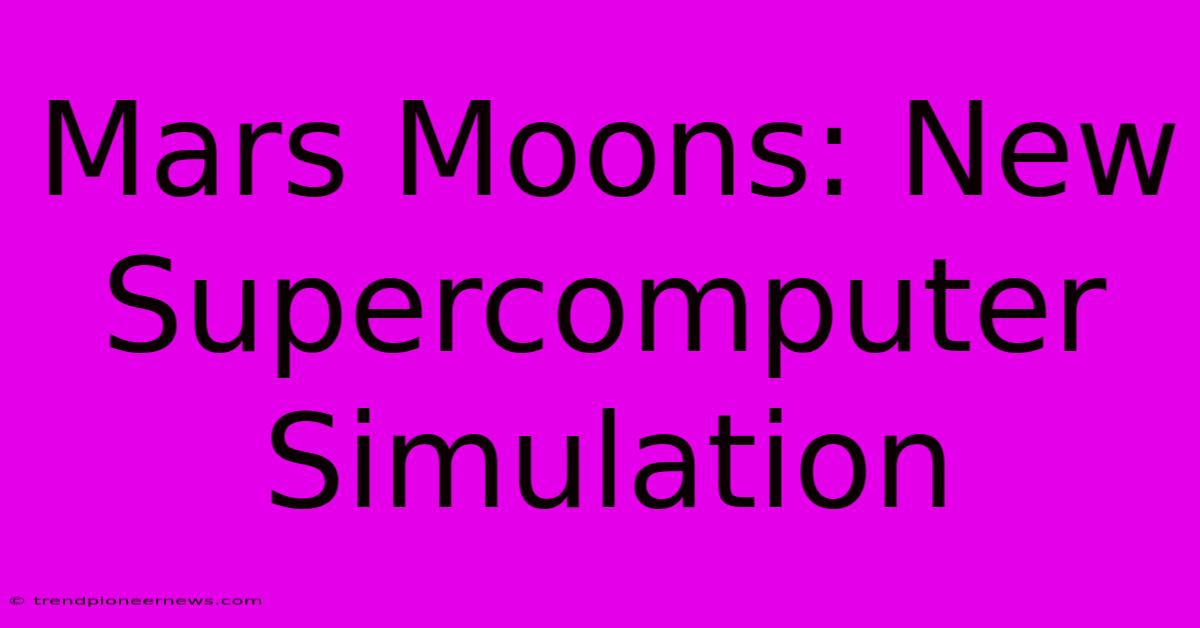Mars Moons: New Supercomputer Simulation

Discover more detailed and exciting information on our website. Click the link below to start your adventure: Visit Best Website Mars Moons: New Supercomputer Simulation. Don't miss out!
Table of Contents
Mars Moons: Decoding Phobos and Deimos with a New Supercomputer Simulation
Hey everyone! So, I've always been obsessed with space. Seriously, like, obsessed. And Mars? Forget about it. I spend hours reading about its geology, its potential for past or present life… you name it. But lately, I've been totally engrossed in its moons, Phobos and Deimos. They're weird, you know? Tiny, potato-shaped things orbiting a really cool planet. And recently, I stumbled upon this amazing new research using supercomputer simulations to model their formation. Let me tell ya, it's mind-blowing stuff!
The Mystery of Mars' Moons
For years, scientists have been scratching their heads over these two little guys. They're unusually small and irregularly shaped compared to most moons in our solar system. It's made figuring out their origin a real head-scratcher. Are they captured asteroids? Did they form from the same material as Mars itself? The possibilities were endless and honestly, a bit frustrating. It felt like a giant cosmic puzzle with missing pieces.
I remember one time, I was trying to explain the different theories to my niece – a total space-nerd like me – and I got so tangled up in explaining the accretion disk model versus the capture hypothesis that I almost gave myself a headache. It was a mess, I’ll admit it.
Entering the Supercomputer: A New Dawn in Martian Moon Research
This new research, though? It's a game-changer. Researchers used a supercomputer, which is like, a bajillion times more powerful than my laptop (obviously!), to run incredibly detailed simulations. These simulations modeled the formation of Mars and its moons over millions of years, considering factors like gravity, collisions, and the composition of the early solar system. They really went all out.
The results? Well, they're pointing towards a pretty compelling theory: a giant impact, similar to the one that's thought to have formed Earth's moon. Except instead of one big moon, this impact on early Mars apparently resulted in a debris field that eventually coalesced into Phobos and Deimos. Pretty cool, huh?
This new simulation really fleshed things out. I mean, you have to appreciate this level of detail. They’re able to model things like the mass, size, and orbital characteristics of the moons with a much higher degree of accuracy. You can really appreciate the nuance of the theory, and it made so much more sense to me. This also helps explain their irregular shapes, and smaller sizes compared to the moons of other planets.
Actionable Insights for Space Enthusiasts and Researchers
- Embrace New Technology: Supercomputers are revolutionizing planetary science. Keep your eye out for more research utilizing these powerful tools.
- Explore Diverse Theories: The origin of Phobos and Deimos isn't settled. Understanding the different hypotheses is key to appreciating the complexity of planetary formation.
- Stay Updated: Follow reputable sources, such as NASA, ESA, and scientific journals to learn about the latest discoveries and interpretations.
This new research is incredibly exciting. The more data scientists uncover, the better we understand this whole solar system. Plus, it's an incredible reminder of the power of collaboration and scientific inquiry. And honestly, for a space nerd like myself, it's just plain awesome. So keep looking up, folks, and keep exploring! There’s tons to discover! Who knows what other secrets the Red Planet holds?

Thank you for visiting our website wich cover about Mars Moons: New Supercomputer Simulation. We hope the information provided has been useful to you. Feel free to contact us if you have any questions or need further assistance. See you next time and dont miss to bookmark.
Featured Posts
-
Gunners Rout Sporting 5 0
Nov 27, 2024
-
Vauxhall Luton Plant Closure Announced
Nov 27, 2024
-
Trump Tariffs Hidden Costs
Nov 27, 2024
-
Live Cricket Score Sa Vs Sl Test
Nov 27, 2024
-
Canada Post Strike No Deal In Sight
Nov 27, 2024
